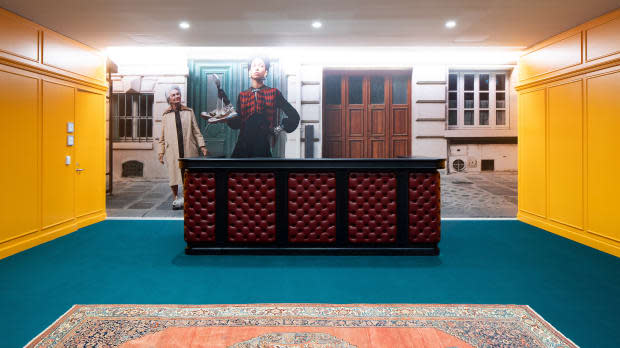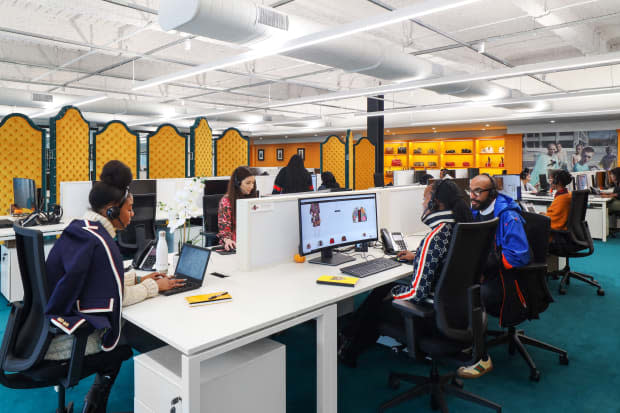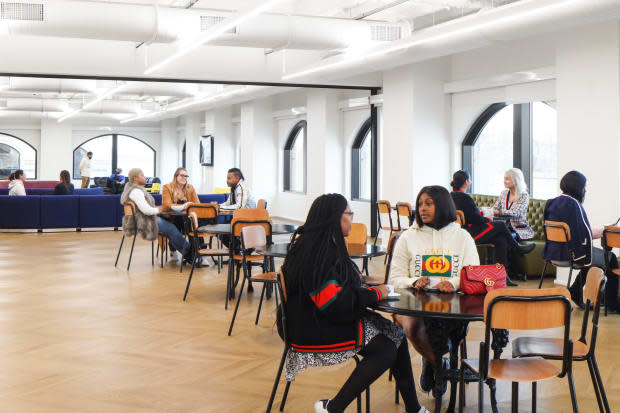Even Gucci's Client Service Centers Get the Alessandro Michele Touch
Gucci 9 Hudson is a technology-powered customer touchpoint with a human heart, the brand's CEO and President Marco Bizzarri explains.
There are only two things inside Gucci 9 Hudson, the Italian brand's new North American Client Services Center, which betray that we are in New Jersey and not, say, inside Gucci's showrooms in Milan: A sweeping view of downtown Manhattan across the river and large TV screens scattered across the rooms displaying live stats.
Otherwise, this could be any space within the Gucci empire, whether it's a boutique in Tokyo or the Gucci Garden in Florence. Imagining a customer service center brings to mind "Office Space"-like images of drab, grey cubicles meticulously lined up across a windowless room. Not so at Gucci 9 Hudson; that kind of depressing surrounding doesn't fit into the world of creative director Alessandro Michele, who helped design the space.
"I remember he saw the pictures of this place — where it is located, the view — he was so happy to try to create something unique for this location, it was not even a problem to ask him to do it," explains Marco Bizzarri, CEO & President of Gucci. "Actually, this is the approach of Alessandro: He's really so much in love with what he's doing, I can feel that in everything that he is supervising."
Related Articles
Gucci Announces That It Is Now 'Entirely Carbon Neutral'
Say Goodbye to Gucci's 'Guccification' Come Spring 2020
Gucci Announces Community Fund and Scholarship Program to Foster Diversity and Inclusion
This translates into wide, airy spaces, with warm wood floors and antique rugs in break areas, teal carpeting and orange walls around the office and plush pink curtains in a training room. (The desks, however, are still a standard-issue white; perhaps it's time for Gucci to get into office furniture?) Scattered around the room are three-panel dividers in bright-orange velvet, which serve both to dampen the sound in the room and as a portable means to divide up the teams — here by work segments, but in other international hubs, they group by language. Gucci has invested so much into making it a beautiful space that Bizzarri jokes he'd like to switch his office from Milan to Jersey City.

"To be surrounded by beauty and beautiful things and beautiful minds, I think, is going to help a lot in terms of interaction with the customers," he explains. "That's exactly what we want when they enter in our shops in any brick and mortar shops in the world."
The model of Gucci 9 Hudson is similar across client service centers in Florence, Tokyo, Singapore and Seoul, all of which also carry the name "Gucci 9" (so named because the first center, which opened in Florence in December, was the ninth building on campus), and all of which were designed with the Michele touch. Of course, it's unusual to see a creative director give input on something as behind-the-scenes and corporate as a client services center, especially one as busy as Michele.
"Listen, Alessandro is kind of a strange bird," Bizzarri says with a grin. "First of all, for the size of Gucci, he's the only creative director; if you look at competition, they want two or three or four teams at a time, with many different creative directors, people taking care of different categories. Alessandro is overseeing everything that is related to the touch points with clients — and he loves that as well."
That's because, ultimately and obviously, the entire point of a client service center is to create another avenue between the brand and the people buying its goods. Gucci 9 Hudson currently services 41 North American stores, with the potential to reach future locations and shop-in-shop boutiques. There are even mini-showrooms set up with a selection of current product, and employees are decked out with wireless headsets so that they can answer detailed questions about something like the latest sneaker or this season's bag. This way, Gucci is able to assist customers without adding an additional strain on in-store employees, who themselves are quite busy, while still providing the same level of service.

"We have many, many customers, so [the stores] are quite crowded. One of the problems that we face is that someone calling the shops was not able to get an answer because everybody was busy. It was not the fact that we were snobby, it was impossible to ask or even to stay on the phone longer, because then you [are] going to lose the sales from the customers that are entering the shop," Bizzarri explains. "In this case, we are able to serve and to answer quicker, to give a better service."
But don't call it a "call center" — that's too outdated a model. Here, employees also email and live chat, and can develop one-on-one relationships with customers. (Over the course of the tour, it is emphasized multiple times that client advisors don't have ownership over specific customers, and any employee can take communication from any returning client; these relationships are there for the benefit of the client and to strengthen their ties with Gucci, and client advisors are not incentivized by commission to be territorial.)
That brings us back to those TV screens with live stats, both for the North American center and for Gucci's global network. They keep track of how many calls or chats are coming in, how many employees are currently attending to clients or away from their desks, and, of course, a stat listing how many calls are taken versus how many have gone unanswered. This helps client advisors determine how to best handle their workload rather than to serve as an iron-fisted motivator to take as many calls as possible, as employees aren't evaluated by the number of calls taken or length of calls but rather the level of customer satisfaction. (To their credit, the percentage of calls taken was also quite impressive.)
Tracking these numbers isn't the only way Gucci is harnessing the power of technology for these centers. One screen was dedicated solely to showing what was happening on the North American website, with little figures tracked by IP address denoting customers who were returning accounts, those who were coming to Gucci for the first time, those who were shopping on mobile versus web, those who were leaving with full shopping baskets or those who were sitting in checkout for an extended period of time. Deciding when to live chat with those customers is more an art than a science, a delicate balancing act between being intrusive and being neglectful. Employees were also provided with a script generator that learns words and phrases from previous calls to better answer questions coming in on new ones. But at the center of it all is still those human client advisors.

The idea is for technology to help guide one-on-one interactions, Bizzarri explains. "The kind of experience that you like to give to the customers is going to be more and more centered to the human touch of the person-to-person clients. We believe that technology is going to be super important to help us, to support us, but we will never change that approachability with the client."
The hiring process for Gucci 9 Hudson was designed with that ethos in mind. According to Bizzarri, a full quarter of the 150 employees come from the Gucci Exchange Internal Mobility program, meaning they moved up from working in retail shops. The rest were hired through an interesting process; first, potential candidates were invited to a networking session, no interviews or resumés necessary. The next step was bringing in candidates for "blind" interviews, conducted with interviewer and interviewee sitting back-to-back.
"We believe that smile has a sound and can change dramatically the way we perceive a person talking, if he's smiling or not," Bizzarri explains. "So we did blind interviews to avoid any kind of bias, in terms of culture, gender, nationality, ability or disability, and that created a unique approach to the way in which we hired people, and this I think is a very good way to think about how we talk to people, because in many cases, we are biased towards the person we have in front of us [who] could instead give a lot of added value."
This might all sound like a lot for a place most customers will never even see. But considering how much cash Gucci has been raking in since Michele took over — it was recently named the fastest-growing luxury label of 2019 — it's clear the brand has its finger on the customer's pulse. And given today's turbulent retail landscape, excelling in customer service is more important than ever.
Want the latest fashion industry news first? Sign up for our daily newsletter.
